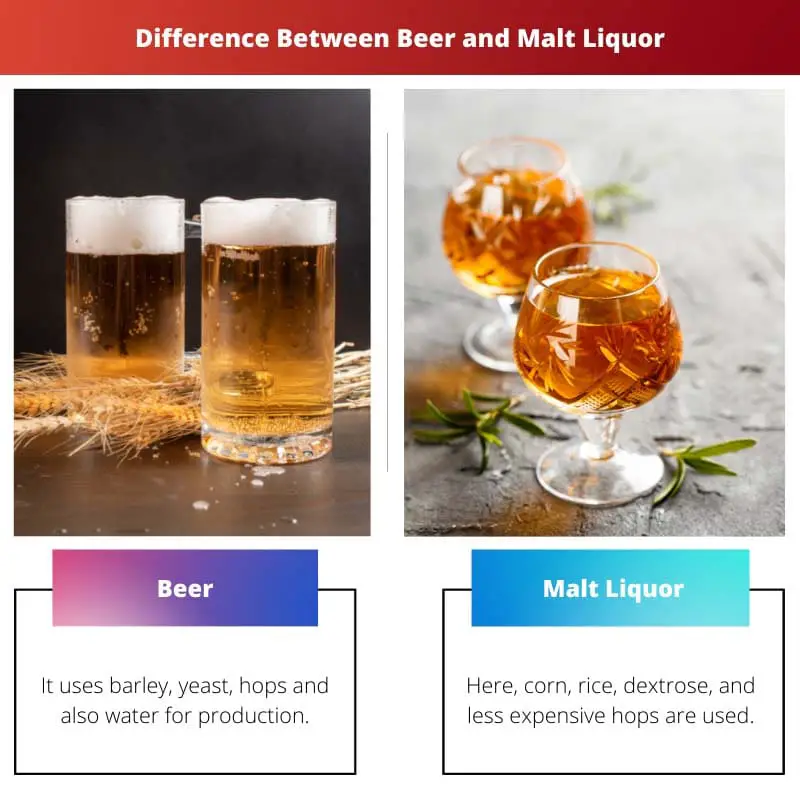At a base level, beer and malt liquor have the same production process. These alcoholic beverages are pretty similar in a few aspects.
Key Takeaways
- Both beer and malt liquor are alcoholic beverages made from fermented grains, but malt liquor has a higher alcohol content, ranging from 6% to 12% alcohol by volume (ABV).
- Beer is brewed using a mix of malted grains, primarily barley, and comes in various styles and flavors, with an average ABV of 4% to 6%.
- Malt liquor is created using a high percentage of malted barley or other grains. It includes additional sugars or adjuncts to increase the alcohol content, resulting in a sweeter, stronger taste than beer.
Beer vs Malt Liquor
The difference between beer and malt liquor is that the former has a lower alcohol content of 3% to 15%, compared to the latter, which has a higher alcohol content of 12% to 20%.

Beer is an alcoholic beverage made using malted cereal grains, hops, and water fermented with the help of yeast. Sugar is extracted from grains, and the yeast converts these sugars into alcohol.
Malt liquor is brewed to have high alcohol content, light colours, and a mix of several sweetening agents. A thing to note about malt liquor is that corn is used in its production instead of barley.
Comparison Table
| Parameters of comparison | Beer | Malt Liquor |
|---|---|---|
| History | The ancient Egyptians first discovered the brewing process; ever since beer has become popular in many cultures. | In 1948, Clix was granted a patent for producing the first malt liquor beverage in the USA. |
| Production process | It uses barley, yeast, hops and also water for production. And it can be top or bottom-fermented. | Corn, rice, dextrose, and less expensive hops are used here. Malt liquor is only bottom fermented to keep the sugars trapped. |
| Alcohol content | Beer is seen to have a comparatively lower alcohol content range of 3% – 15%. | Malt liquor has a higher alcohol content range from 12% to, at most, 20%. |
| Flavour | Beer has a distinct and bitter taste due to adding hops in the production process. | Malt liquor contains added sugars due to the fermentation process, making it sweeter than beer. |
| Cost | Due to the addition of expensive hops for a smoother taste, beer is comparatively costlier than malt liquor. | Here, the ingredients are cheaper, so the final price per ounce is less expensive than beer. |
| Bottle ounces | Beer is packed within 12 oz bottles, and this quantity is still costlier than malt liquor. | Malt liquor is packaged within 40 oz bottles or more around the world and has a lower cost for packaging. |
What is Beer?
Beer has been an integral part of the world even before 5,000 B.C. when the Egyptians first introduced its production process.
The Egyptians developed a method of brewing with the help of paper scrolls, dates, herbs and pomegranates.
The ingredients necessary for brewing beer involve using malted cereal grains, hops, and water. These ingredients are all added together, and the fermentation process takes place with the help of yeast.
Beer gets its sugars from barley and cereal grains, and the yeast uses this sugar and turns it into alcohol. Now, even though these sugars are added, beer still is seen to have a bitter taste compared to other alcoholic beverages.
The bitter taste can be attributed to adding hops, which counter the sugars present in the fermentation process and provides an added flavour.
Brewers try to keep the alcohol content of beer lower than most beverages, at around 3% to 15%, with no added sugars or ingredients.
Now the ingredients present in beer, such as hops and grains, are more expensive to purchase, which, in turn, increases the final costs of the packaged beer and makes them costly.
Beer is also packaged and shipped in 12 oz bottles to sell more quantities to several distributors.

What is Malt Liquor?
Malt liquor is a unique alcoholic beverage introduced by the company Clix back in 1948 in the USA.
They had applied for a patent for the brewing process, and soon after, other companies started to adopt their methods to produce and popularise malt liquor.
In the brewing of malt liquor, we observe that the main ingredients consist of cheaper and more affordable products such as corn, rice, dextrose, and less expensive hops.
These ingredients are mixed, and a bottom fermentation process is carried out to trap the added sugars and make the drink sweeter.
The added sugars are also the reason why malt liquor is seen to have a higher alcoholic content than its counterpart beer. The content range starts from 12% to upmost 20%.
The cost of malt liquor per 40 oz bottle is also cheap as compared to other alcoholic beverages due to the lower brewing costs for it.

Main Differences Between Beer and Malt Liquor
- Beer was developed and brewed even before 5,000 B.C. by the Egyptians, while malt liquor was produced recently in 1948 by the company Clix in the USA.
- The ingredients for beer production include hops, water, malted cereal grain and yeast for fermentation, while for malt liquor, the elements include corn, rice, dextrose, and less expensive balls.
- Beer is fermented using either a top or bottom fermentation process. In contrast, malt liquor is fermented with the help of only bottom fermentation to capture the sugars for flavour.
- Beer is bitter as compared to malt liquor, which contains added sugars.
- The alcohol content in beer ranges from 3% to 15%, while the alcohol content range for malt liquor is from 12% up to 20%.

- https://onlinelibrary.wiley.com/doi/abs/10.1097/01.ALC.0000156118.74728.34
- https://www.astm.org/DIGITAL_LIBRARY/JOURNALS/FORENSIC/PAGES/JFS14603J.htm

The detailed breakdown of the production process and ingredients provides valuable insights into the craftsmanship behind beer and malt liquor.
I couldn’t agree more. The thorough examination of production methods adds depth to the comparison.
Absolutely, Myoung. It’s refreshing to see such meticulous attention to detail in discussing these beverages.
The article effectively elucidates the brewing and fermentation techniques used in both beer and malt liquor, shedding light on their distinctive characteristics.
I appreciate the attention to detail in presenting the brewing methods of beer and malt liquor. It underscores the precision and skill involved in their production.
Indeed, Vkhan. The emphasis on technique and process contributes to a comprehensive understanding of these beverages.
The comparison of alcohol content and cost is particularly insightful. It clarifies the economic and sensory differences between these beverages.
I found the section on alcohol content and flavor to be very informative. It’s helpful for making informed choices about beverage preferences.
This article provides a comprehensive analysis of the differences between beer and malt liquor. The historical context and the comparison table perfectly demonstrate the unique aspects of each beverage.
I couldn’t agree more. The detailed comparison table really highlights the key differences in a clear manner.
I appreciate the in-depth exploration of the brewing process and ingredients used in both beer and malt liquor. It’s fascinating to learn about the historical origins of these beverages.
I found the historical background particularly intriguing. It adds a valuable cultural context to the discussion.
Absolutely, the historical context provides a rich foundation for understanding the evolution of beer and malt liquor.
The article’s exploration of beer and malt liquor is thorough and informative, lending valuable knowledge to connoisseurs and enthusiasts alike.
Absolutely, Morgan Alan. It’s a compelling read for anyone interested in the nuances of beer and malt liquor.
While the article effectively outlines the distinctions between beer and malt liquor, it could benefit from deeper exploration of cultural associations and consumption patterns.
I understand your point, Thall. Further examination of cultural and social contexts related to these beverages could enhance the overall analysis.
The article presents a clear distinction between beer and malt liquor, offering a comprehensive overview of their essential characteristics.
Indeed, Shunter. The article succeeds in delineating the unique traits of beer and malt liquor with precision.
The detailed comparison between beer and malt liquor provides a nuanced understanding of these beverages, catering to an audience with diverse preferences.
Absolutely, Benjamin53. The thoroughness of the analysis addresses the distinct tastes and characteristics valued by different consumer segments.
I concur with your assessment, Benjamin53. The article effectively captures the multifaceted appeal of beer and malt liquor.
While the comparison is well-structured and detailed, the article could benefit from addressing the environmental implications of beer and malt liquor production processes.
A valid point, Mwalker. Exploring the ecological footprint of these beverages would add a significant dimension to the analysis.